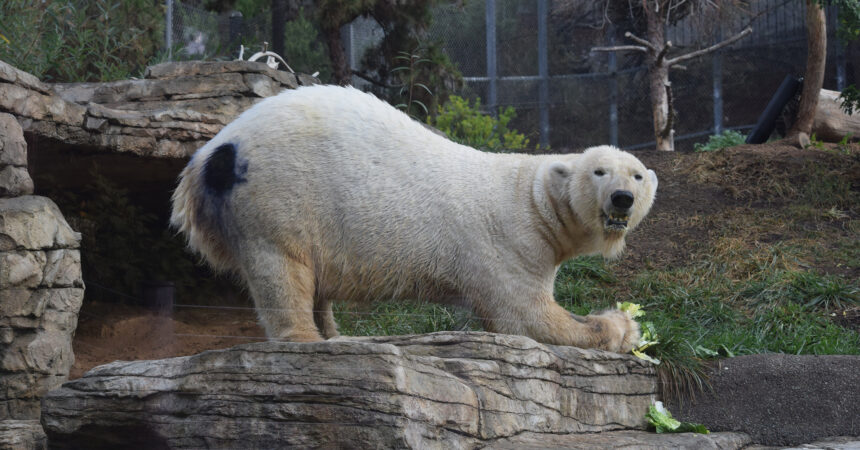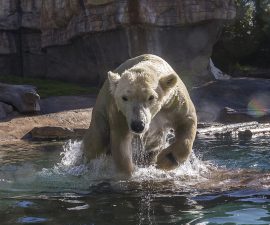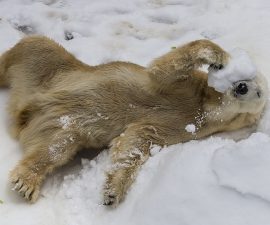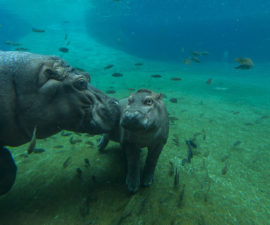Tatqiq the 609-pound polar bear lumbers across the rocks and grass at the San Diego Zoo’s Conrad Prebys Polar Plunge. As she dives into the water, visitors marvel at her sharp teeth, her dinner-plate sized paws … and the big purple polka dot on her rump.
What’s the bold new hair color all about? Tatqiq—one of three polar bears that call the Zoo home—is contributing to a scientific study to learn how fast polar bear hair grows. This information will help scientists gain insight into the species’ diet, nutrition, and more, better equipping them to protect bears far up on the Arctic Ocean’s frozen sea ice.
In the Arctic, polar bear food is becoming harder to come by. These formidable predators rely on meals of fat-rich seals to develop a thick layer of fat, which stores calories and allows polar bears to survive through periods of fasting. On Hudson Bay, where the sea ice melts completely each summer, polar bears are forced ashore with no access to the seals they depend on for survival. In the late fall, they wait for the water to freeze over again, so that they can wander out in search of food. But as humans burn more fossil fuels, producing rampant emission of carbon dioxide—which traps heat around the Earth like a thick blanket—the Arctic’s sea ice is shrinking, and polar bears are losing the hunting platform they use to find prey.
Polar bear hair (and human hair) acts like a time capsule, preserving clues about what an individual eats, how much stress they’ve experienced, what pollutants they’ve been exposed to, and whether they’ve reproduced. To measure the impact of sea ice losses on polar bear health, scientists can use hair samples to determine if polar bears in the Arctic are meeting their nutritional needs or if some have turned to seal alternatives. But they are still missing a key piece of the puzzle: knowing when a particular food was consumed.
Tatqiq’s voluntary participation in this innovative study will allow scientists to effectively put a time stamp on hair samples from Arctic bears. After the dye is applied to the bear’s fur, scientists measure how long it takes for their naturally transparent, tube-like hairs to reappear. It’s something like watching a person who had their hair colored at a salon, to see how long it takes for their natural hair color to show at the roots.
In addition to the new hair color spot, which is already beginning to fade, Tatqiq is given a special supplement in her diet containing a harmless isotope. The isotope causes a distinctive “band” in the hair growth, visible to scientists when they analyze the fur in a lab. By recording the time between Tatqiq eating the supplement and the band revealing itself in a strand of her hair, and combining that information with visual data from the hair dye, scientists hope to get a complete picture of how quickly polar bear hair grows over the course of a year.
“Polar bears live on remote and often inaccessible Arctic sea ice,” says Megan Owen, Ph.D., corporate director of wildlife conservation science at San Diego Zoo Global. “The voluntary participation of Tatqiq is invaluable for building our collective knowledge about her species, and ultimately in securing its future,”
Wildlife care specialists at the Zoo spent months patiently working with Tatqiq through positive reinforcement training sessions, helping her learn to push her fur against a protective mesh barrier and hold still while the hair dye is applied. High-value, chicken-flavored food rewards are given when Tatqiq completes each behavior. “Utilizing a positive relationship with Tatqiq, combined with their dedication and expertise, allowed our wildlife care team to ensure her successful participation,” says Matt Akel, a wildlife care manager at the Zoo.
The project is led by the University of Washington and the U.S. Geological Survey (USGS) Alaska Science Center. Along with San Diego Zoo Global, collaborators include Louisville Zoo, Old Dominion University, Aarhus University, and Centre College. Support comes from San Diego Zoo Global, the Dr. Holly Reed Wildlife Conservation Fund, and the USGS.
Collaborative efforts to understand and protect polar bears couldn’t come at a more urgent time. The International Union for Conservation of Nature estimates that just 26,000 polar bears remain across their range, which includes the US (Alaska), Canada, Russia, Greenland, and Norway (Svalbard). Polar bears’ continued survival may depend on human action to reduce carbon emissions, for the health of the Arctic and the planet as a whole.





